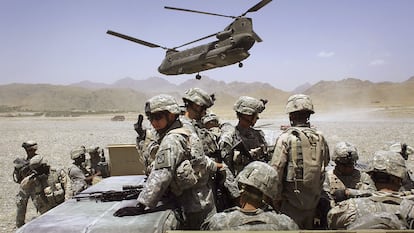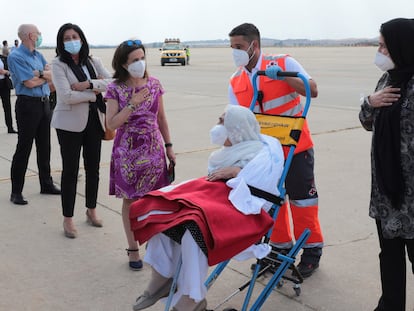The black hole of corruption that swallowed up US investment in Afghanistan
Programs based on unrealistic objectives, excessive levels of aid and a lack of local understanding have contributed to financial disaster as well as military failure in the country


The chaos unleashed in Kabul has transformed the popular decision to withdraw United States troops from Afghanistan into a debacle. But what has happened is neither a surprise nor an inevitability, nor the unfathomable curse of a country where invading empires have repeatedly foundered and retreated.
Afghanistan has collapsed like a house of cards despite repeated warnings from diplomats, military officials and observers on the ground. Eleven separate reports by the Special Inspector General for Afghanistan Reconstruction, a position created by US Congress in 2008, have reported systemic failures in the Central Asian country. A lack of long-term political perspective was papered over by ever-increasing injections of funds, and was aggravated by insufficient information sharing between the different US agencies involved in Afghanistan. But the real black hole is the country’s endemic corruption, which in 2010 was already swallowing 25% of the national GDP, and into which billions more dollars have vanished.
The free-flowing dollars of international aid have further undermined the country’s weak foundations, according to many analysts. The high levels of spending have created so-called “donor fatigue,” where international agencies tire of opening their wallets without seeing results, but have more worryingly served to fatten the Dubai bank accounts of Afghan officials. “Donors simply spent too much, too fast, in too small an economy, with far too little oversight,” said John F. Sopko, the Special Inspector General appointed by Barack Obama, back in 2019. “We turned a blind eye or simply were ignorant of how regularly some portion was going to payoffs, bribes, and bank accounts in Dubai.” Now former president Ashraf Ghani has had to deny that he fled Afghanistan with $160 million in his suitcase.
Sopko presented his last assessment in August of this year. “After spending 20 years and $145 billion trying to rebuild Afghanistan, the US government has many lessons it needs to learn … [to] save lives and prevent waste, fraud, and abuse in Afghanistan, and in future reconstruction missions elsewhere around the world,” his report stressed. The world has spent $2.2 trillion on the Central Asian country, not to mention the cost of the lives of tens of thousands of Afghans and foreigners. The Costs of War project at Brown University puts the death toll from the conflict at 241,000.
Sopko is not the only one at top levels of the US government who has long identified the problem. Twenty declassified documents published on August 19 by the National Security Archive, which is linked to George Washington University, reveal how sources on the ground continually contradicted the Pentagon’s official optimism. Pakistan offered shelter to the Taliban while maintaining a close relationship with Washington, while corruption in the Afghan leadership fed the Taliban insurgency. A statement from the archive upon the documents’ release said White House policy since 2001 was not a miscalculation but deliberately misleading. “The US government under four presidents misled the American people for nearly two decades about progress in Afghanistan, while hiding the inconvenient facts about ongoing failures inside confidential channels,” the statement said.
Biden himself ignored warnings from senior military commanders in the spring when they urged him to avoid a total withdrawal and to leave some form of troop presence to avoid a power vacuum. Sopko’s report recalls the repeated assurances given by US military high command, including Generals David Petraeus in 2011, John Campbell in 2015 and John Nicholson in 2017, of the “growing operational capability” of the Afghan security forces. “More than $88 billion has been appropriated to support Afghanistan’s security sector. The question of whether that money was well spent will ultimately be answered by the outcome of the fighting on the ground,” Sopko said prophetically, just two weeks before the country’s collapse.
The National Security Archive details the problems that plagued the mission from its inception, with particular emphasis on “endemic corruption driven in large part by American billions and secret intelligence payments to warlords.” But everyday activities also required bribes: preferential treatment at a hospital, transporting fuel around the country, or ownership of property.
“Everyone was well aware of the widespread corruption at the highest levels of power. For years the international community has been trying to fight it. When Ghani became president, donors imposed 20 conditions on him, the first of which was to reduce corruption in the administration by 80%,” explained Brookings Institution researcher Vanda Felbab-Brown, citing corruption in the security forces and the judiciary as key examples.
Unlike the authorities propped up by the international community, she added, “the Taliban have not been corrupt, the drug profits [from opium trafficking] were enough for them, and they were not the only ones involved in that; there were also people from the government.”
“In the 1990s they built up a reputation for integrity, with very sporadic cases of diverting money into private pockets, for the benefit of their families, but not systematically like the country’s authorities,” Felbab-Brown added. Although their legitimacy is questionable, she concedes, the Taliban could not be accused of being corrupt given that bribing judges was eradicated in the Islamic courts as a practice during their first term [1996-2001]. This argument may partly explain the popular support for the Taliban in large parts of the country.
In other cases that fell short of corruption, there was a huge amount of waste spent on unrealistic funding targets. Between 2003 and 2015, one 140-page Sopko report argues, the US spent more than $1 billion on institution-building programs, and 90% of those funds went toward developing a standardized judicial system. It was another misjudgment because of the impossibility of imposing formal institutions in an informal environment. “For the first year after Marjah [Helmand] was cleared [in 2010], formal judiciary officials only heard five cases because no one was used to it. Locals would tell us, ‘We’ve never seen this and need to see if it works’,” Sopko reports being told, noting that the vast majority of civil disputes were settled through traditional community channels.
The report’s conclusion is clear: “The US government did not understand the Afghan context and therefore failed to tailor its efforts accordingly,” it states. Meanwhile, “the US government consistently underestimated the amount of time required to rebuild Afghanistan, and created unrealistic timelines and expectations that prioritized spending quickly. These choices increased corruption and reduced the effectiveness of programs.” A lack of evaluation and monitoring by the government agencies and the weight of endemic corruption were greater enemies than the insurgency, former US Ambassador to Afghanistan Ryan Crocker has said.
Felbab-Brown tries to stay optimistic. “One can only hope that the gains in areas such as health – especially maternal and child health – and education are not squandered. The Taliban will not be able to sustain those gains if their funding is cut off, if they are not able to pay salaries, and one can only hope that the generation of technocrats educated abroad will be able to carry out their work if they are allowed to do so,” she said.
Tu suscripción se está usando en otro dispositivo
¿Quieres añadir otro usuario a tu suscripción?
Si continúas leyendo en este dispositivo, no se podrá leer en el otro.
FlechaTu suscripción se está usando en otro dispositivo y solo puedes acceder a EL PAÍS desde un dispositivo a la vez.
Si quieres compartir tu cuenta, cambia tu suscripción a la modalidad Premium, así podrás añadir otro usuario. Cada uno accederá con su propia cuenta de email, lo que os permitirá personalizar vuestra experiencia en EL PAÍS.
¿Tienes una suscripción de empresa? Accede aquí para contratar más cuentas.
En el caso de no saber quién está usando tu cuenta, te recomendamos cambiar tu contraseña aquí.
Si decides continuar compartiendo tu cuenta, este mensaje se mostrará en tu dispositivo y en el de la otra persona que está usando tu cuenta de forma indefinida, afectando a tu experiencia de lectura. Puedes consultar aquí los términos y condiciones de la suscripción digital.
More information
Archived In
Últimas noticias
Welcome to the post-religion era: The idea of Christianity as the absolute truth has become obsolete
‘I thought you would like it’: The risky sexual practice popularized by TV shows and TikTok
The digitalization of tourism: ‘They promise experiences and gave us the worst possible one’
Mexican peso defies uncertainty with forecasts of a new period of stability in 2026
Most viewed
- Sinaloa Cartel war is taking its toll on Los Chapitos
- Reinhard Genzel, Nobel laureate in physics: ‘One-minute videos will never give you the truth’
- Oona Chaplin: ‘I told James Cameron that I was living in a treehouse and starting a permaculture project with a friend’
- Why the price of coffee has skyrocketed: from Brazilian plantations to specialty coffee houses
- Silver prices are going crazy: This is what’s fueling the rally










































